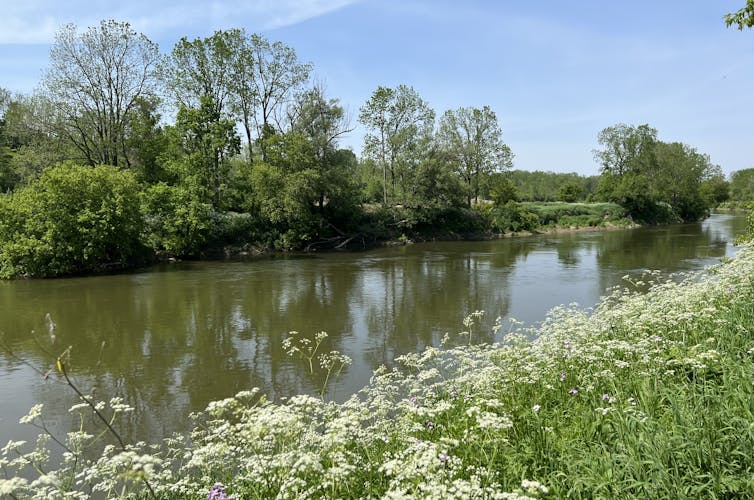By Dr. Brady Deaton, Jr., Department of Food, Agricultural and Resource Economics, and Dr. Sheri Longboat, Rural Planning and Development; Brandon Doxtator, environmental consultation coordinator, Oneida Nation of the Thames; and Prof. Christopher Alcantara, Political Science, Western University
This article is republished from The Conversation Canada under a Creative Commons licence. Read the original article.

Recently, the federal government announced its intention to fulfil its responsibility and fund the construction of a new drinking water pipeline between the Oneida Nation of the Thames and the Lake Huron Primary Water Supply System.
A long-term drinking water advisory has been in effect on the Oneida Public Water System since 2019, affecting community homes and buildings. For this reason, the federal government’s announcement is hopeful news.
Much of our research, which we review in this article, explores the potential of collaborative arrangements to improve drinking water quality outcomes in First Nations communities.
Water sharing arrangements, like the proposed one between the Oneida Nation of the Thames and the Lake Huron Primary Water Supply System, have the potential to enhance water security, but they require strong communication and co-ordination between community leaders in addition to adequate financial support.
Key issues

In one of our recently published papers, we point out that water sharing agreements between Ontario municipalities are commonplace. For example, York Region receives water from the City of Toronto.
That said, the commonness of water sharing between Ontario First Nations and municipalities is far lower than it is between municipalities.
These differences are associated with factors like remoteness. A high proportion of First Nations are located in Northern Ontario and located relatively far from nearby communities who could enter into a water sharing arrangement.
But some First Nations, like the Oneida Nation of the Thames, have municipal neighbours within a feasible distance, where water sharing for access to safe drinking water is a viable option.
A few other First Nations are also engaged in similar arrangements. The Mississaugas of the Credit First Nation now receive water from Haldimand County via a connection in Hagersville, Ont. Six Nations of the Grand River have joined in this arrangement with the Mississaugas of the Credit through a boundary watermain. Meanwhile, the Mississaugas of Scugog Island First Nation are collaborating with Durham Region regarding the potential to service Port Perry.
Positive effects of water sharing agreements
In a recent article we find a positive association between enhanced drinking water quality and Indigenous-municipal drinking water arrangements in Ontario.
Using historic data, and controlling for many factors, we find that First Nation drinking water systems in Ontario are more likely than municipal water systems to experience a drinking water advisory.
However, the presence of water sharing arrangements between First Nation systems and nearby municipalities are associated with reductions in the likelihood that a First Nation water system will experience a drinking water advisory.
This is a welcome outcome for all communities.
Partnerships beyond water

Indigenous-local intergovernmental partnerships are not limited to water.
There are numerous types of agreements for community services that exist between First Nations and municipalities. These agreements include fire protection, trash collection, animal control and co-ordinated efforts to recruit medical professionals to serve the communities.
The success of these agreements, as well as the water sharing ones, relies on the acknowledgement of the unique histories and aspirations of the communities and the governments before exploring any partnership.
This includes an appreciation of the nation-to-nation relationship between First Nations and the federal government, Indigenous rights and autonomy, cultural differences, funding, long-term sustainability of the projects and a host of economic considerations, like the costs to implementing and developing any legal contract.
Path to a collaborative future
There is no silver bullet to addressing any specific issue — especially one as chronic and complex as drinking water quality in First Nations communities.
Water servicing agreements should only be viewed as one component of the portfolio of efforts to address this historic problem.
Voluntary mutually beneficial exchanges, like the water sharing agreements, require leadership that enhances trust, transparency and communication between First Nation, municipal and federal governments. And we hope that the evolving relationship between the Oneida Nation of the Thames and the Lake Huron Primary Water Supply System will prove mutually beneficial.
Our research suggests this collaboration has the possibility of improving drinking water quality by reducing the likelihood of persistent drinking water advisories. The emergence and success of collaborative relationships like these will depend on a host of factors that will require purposeful efforts to develop understanding and trust.
The Conversation Canada is always seeking new academic contributors. University of Guelph researchers wishing to write articles should contact Angela Mulholland, News Service Officer
